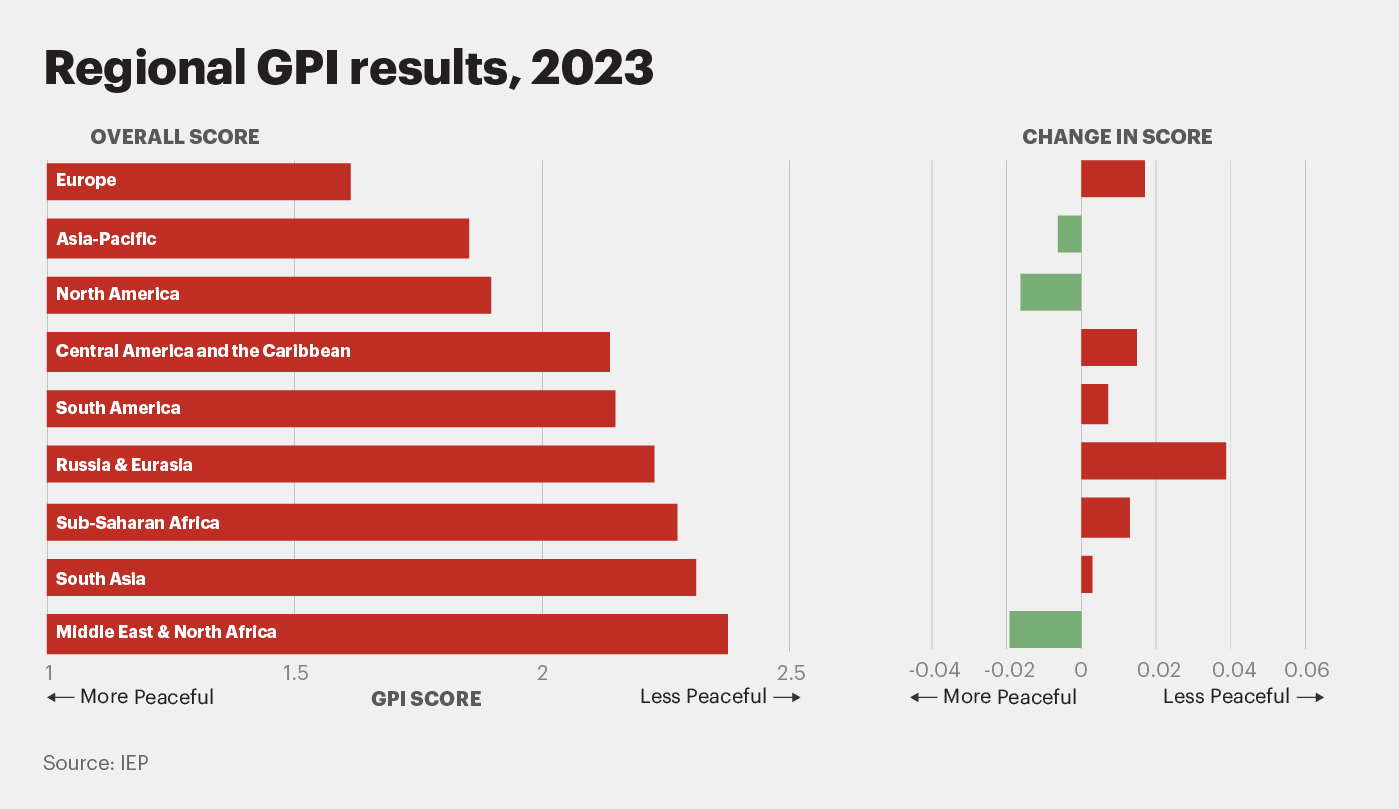
In 2023, six out of nine global regions experienced a decline in peacefulness, with only Asia-Pacific, North America and the Middle East and North Africa showing improvement. Despite 92 countries making progress in reducing military expenditure in 2022, the total global military spending still rose significantly due to the involvement of certain countries in the Ukraine war. The total number of deaths related to conflicts increased by 96%, including both internal and external conflicts, even when excluding Ukraine and Russia from the analysis.
Countries with a history of serious conflicts over the past two decades, such as Libya, Côte d’Ivoire, and Afghanistan, demonstrated remarkable improvements in peacefulness and were ranked among the top five most improved nations in terms of peace.
South America experienced a slight decline in peacefulness due to deteriorations in the Ongoing Conflict and Safety and Security domains. On average, peacefulness in the region increased by 0.33 per cent, with three countries showing improvements and eight witnessing deteriorations. The decrease in peacefulness was primarily driven by internal conflicts, violent demonstrations, and higher incarceration rates. Overall, South America ranks as the fifth most peaceful region globally.
Uruguay continues to be the most peaceful country in South America for the fourth consecutive year and stands among the top 50 most peaceful countries worldwide. However, Uruguay did witness a slight decline in peacefulness, with an overall score deterioration of 0.4 per cent. This was attributed to increases in violent demonstrations, the incarceration rate, and political instability in 2022.
Colombia, on the other hand, exhibits the lowest levels of peacefulness in the region, but it did experience a small overall improvement in its score over the past year. All six indicators in the Militarisation domain improved, especially the UN peacekeeping funding indicator. Despite the overall increase in peacefulness, political stability in Colombia deteriorated throughout 2022, marked by increased social unrest and polarization during the May 2022 presidential elections.
Argentina recorded the most significant improvement in peacefulness in the region and is now ranked 54th in the overall GPI. Improvements were observed in the Militarisation and Safety and Security domains, with no change in the Ongoing Conflict domain. Notably, the violent crime indicator exhibited the largest improvement, and Argentina generally fares better in this regard compared to other Latin American countries.
Conversely, Ecuador experienced the most substantial deterioration in overall score, mainly due to increases in violent crime and deaths from internal conflict. Ecuador’s overall score declined by 6.9 per cent, leading to a drop in rankings by 24 places, landing at 97th overall. Instances of violent crime surged in the country, primarily driven by the rise of organized crime groups, resulting in a spike in homicides in regions like Guayaquil, Duran, and Samborondon.
The Russia and Eurasia region witnessed the most significant decline in peacefulness worldwide, surpassing other regions by more than double the magnitude in 2022. Among the 12 countries in the region, six experienced deteriorations in peacefulness, with Ukraine and Russia facing the most significant declines, ranking as the first and fifth largest deteriorations, respectively.
Russia maintains its position as the least peaceful country in the region and ranks among the least peaceful nations globally in the 2023 Global Peace Index, securing the 158th overall rank. Russia’s peacefulness deteriorated by nearly five per cent, reaching its lowest levels since 2008. The primary driver behind this decline was a four per cent increase in deaths from external conflict, largely due to the Russian-Ukrainian war. However, there were slight improvements in the Safety and Security domains, attributed to enhancements in indicators related to violent demonstrations and incarceration rates.
Ukraine faced the largest deterioration in overall peacefulness, both within the region and globally. Across all domains, Ukraine recorded significant deteriorations, with the most substantial declines occurring in indicators related to deaths from internal conflict, refugees and internally displaced persons (IDPs), and armed services personnel rates. The Russian invasion in February 2022 resulted in widespread displacements, with approximately 30 per cent of the population estimated to be refugees or internally displaced. The conflict’s casualties are still uncertain, but some estimates suggest up to 300,000 casualties, with potential fatalities exceeding 80,000.
On the other hand, Kazakhstan witnessed the most significant improvement in overall peacefulness, showing a 4.2 per cent increase and rising 21 places to rank 76th globally, the third-highest rank in the region. The country experienced improvements in the Militarisation and Safety and Security domains, with violent demonstrations being the most notable indicator with a 50 per cent improvement. While fifteen of the 23 GPI indicators remained unchanged in Kazakhstan, only three indicators deteriorated, namely the incarceration rate, political instability, and military expenditure as a percentage of GDP.
Moldova maintained its position as the most peaceful country in the Russia and Eurasia region for the 16th consecutive year. The country showed a slight overall improvement in peacefulness, driven by advancements in violent demonstrations and perceptions of criminality. However, political stability in Moldova deteriorated by 4.2 per cent in 2022.
The Russia-Ukraine conflict escalated regional instability and raised concerns about potential broader conflicts with NATO alliance partners. This invasion and the consequent sanctions on Russia triggered significant economic disruptions, including notable increases in commodity prices. The domestic economic challenges put pressure on the government to address living conditions for its citizens. Moreover, the conflict led to an unprecedented influx of Ukrainian refugees, further straining Moldova’s resources. The fighting also posed a threat to Moldova’s Russian-backed breakaway region, Transnistria.
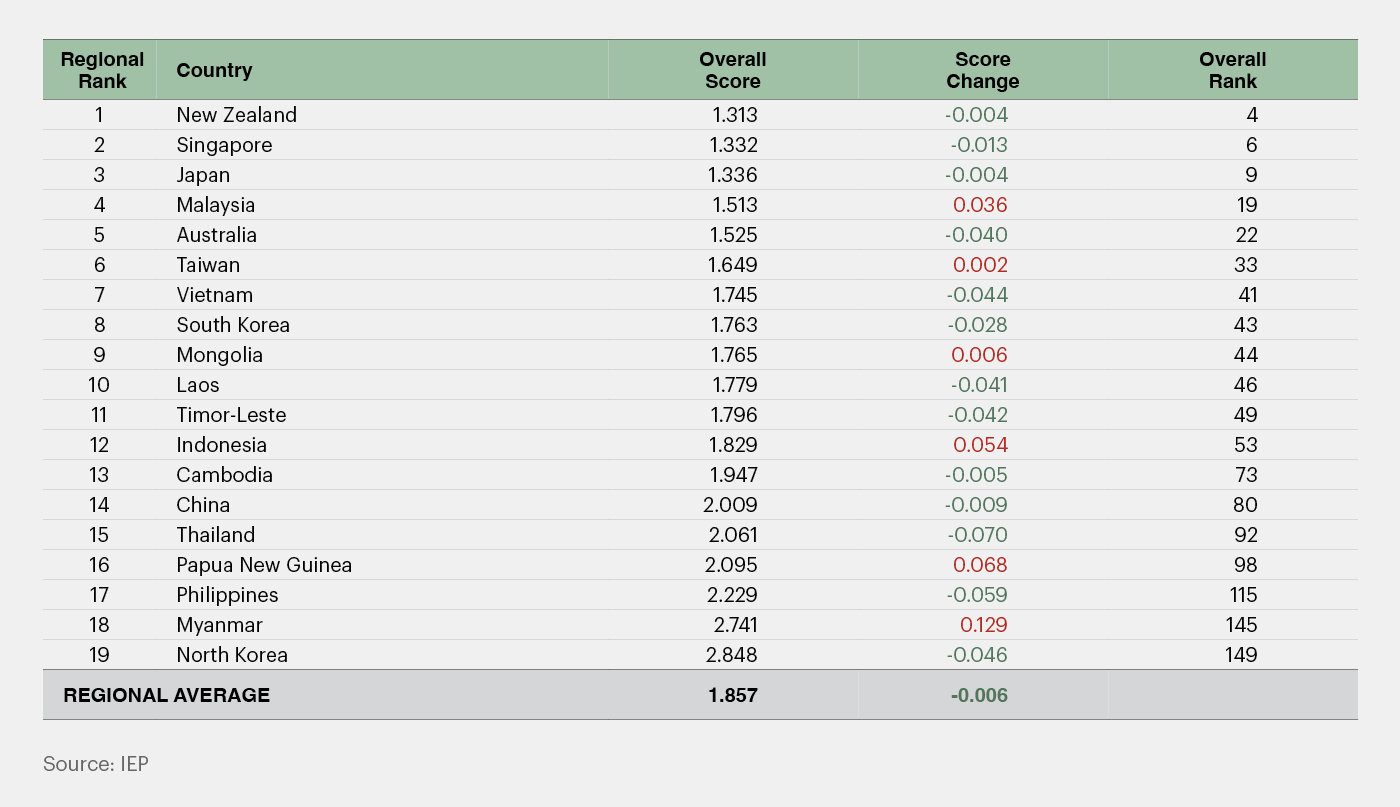
The Asia-Pacific region showed a slight improvement in peacefulness, with a 0.32% increase in its Global Peace Index (GPI) score in 2023. This improvement was primarily driven by advancements in the Safety and Security and Militarisation domains. Violent demonstrations and UN peacekeeping funding indicators played a significant role in enhancing the region’s peacefulness. However, the Ongoing Conflict domain deteriorated by 2.1%, primarily due to worsening conflicts in Myanmar and increased violence in the West Papua region of Indonesia.
Among the countries in the region, 13 nations saw improvements in their GPI scores, while six countries experienced deteriorations. New Zealand stood out as the most peaceful country in the region and the fourth most peaceful globally. Although New Zealand’s overall GPI score improved slightly, there was a six per cent deterioration in the Militarisation domain, primarily attributed to issues related to weapons imports and exports.
North Korea, historically the least peaceful country in the region surprised with the third-largest improvement in 2023. Despite this positive change, perceptions of criminality were the only indicator that worsened. The improvement was likely influenced by the government-imposed national lockdown in response to COVID-19 in 2022, which resulted in border restrictions and limited mobility for months.
On the other hand, Myanmar experienced the largest deterioration in its peace score due to rising political tensions and changes in perceptions of criminality, violent crime, and deaths from internal conflict. The focus on cracking down on political opposition and financial strain on both sides contributed to an increase in serious crimes, including drug trafficking.
Thailand showed the most substantial improvement in the region, with a 3.3% increase in its GPI score. This positive change was driven by improvements in violent demonstrations, political instability, and the incarceration rate. The successful transfer of power after opposition victories in recent elections reduced the likelihood of disruptive protests and restored some faith in the country’s political system.
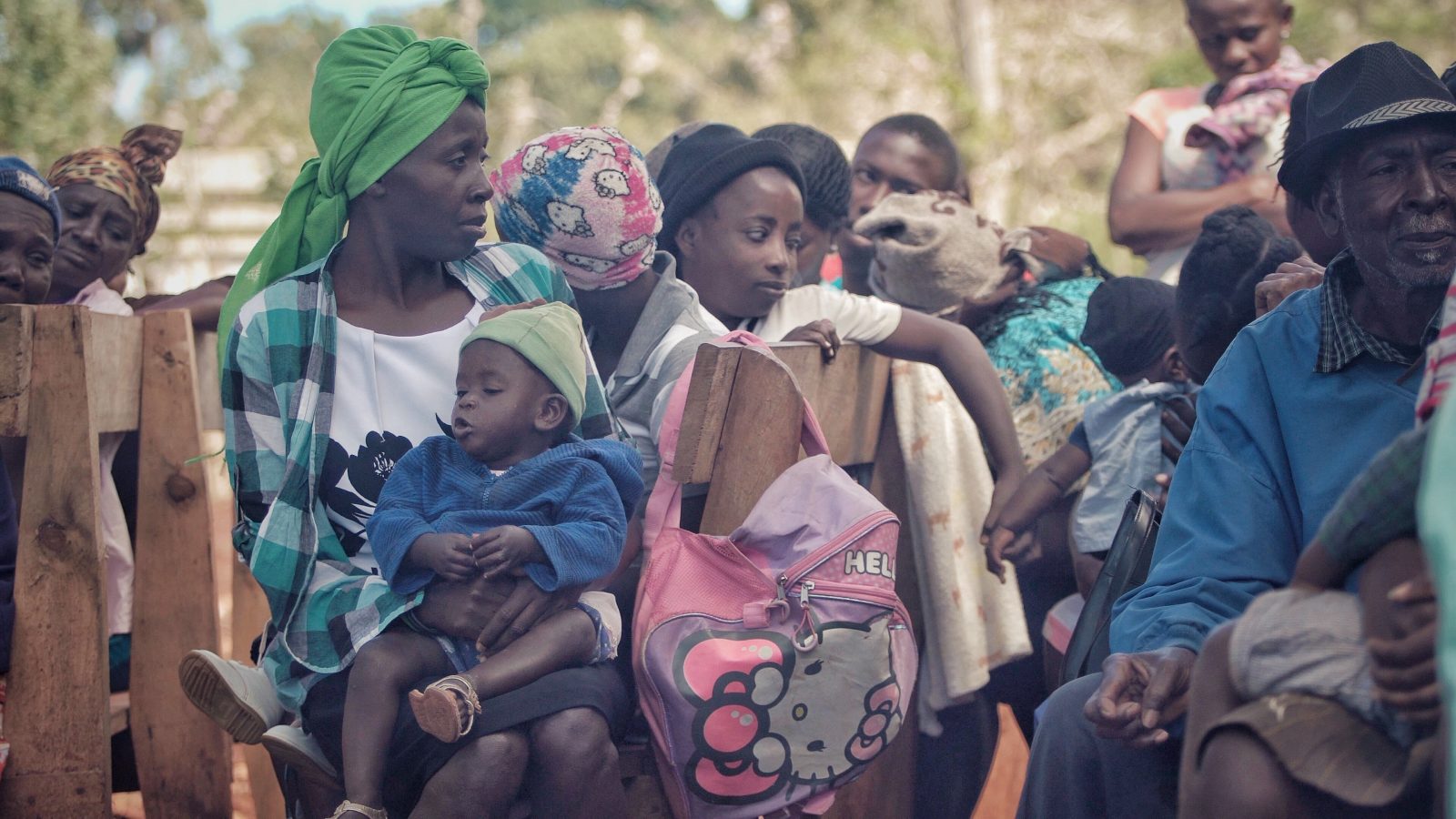
The Central America and Caribbean region experienced a slight decline in peacefulness, with its Global Peace Index (GPI) score deteriorating by 0.71%. Among the 12 countries in the region, only Panama, Honduras, El Salvador, and Haiti saw deterioration, a decrease from the previous year when seven countries experienced declines. The domains of Ongoing Conflict and Safety and Security were the main contributors to the overall decline, while the Militarisation domain showed improvements in all indicators except for the armed services personnel rate. The decrease in peacefulness was mainly influenced by significant deteriorations in political instability and relations with neighbouring countries, which fell by 5.3% and 4.2%, respectively.
Costa Rica retained its position as the most peaceful country in the region and ranked 39th globally in the 2023 GPI. It also recorded the most significant improvement in peacefulness among all countries in the region over the past year. This improvement was attributed to advancements in indicators related to violent demonstrations, incarceration rate, and perceptions of criminality. Both the Militarisation and Safety and Security domains showed improvement, while the Ongoing Conflict domain remained stable. Political stability in Costa Rica showed positive developments in late 2022. Additionally, the country’s low poverty rate contributed to a reduction in social unrest in 2022.
As the largest and most populous country in Central America, Mexico remained the least peaceful country in the region in 2023. However, it showed a slight improvement of 0.65% in the 2023 GPI and climbed three places in the overall rankings to 136th. The improvement was primarily due to progress in the militarisation domain. Although more than half of its GPI indicators remained stable, the country experienced deteriorations in three indicators, including the incarceration rate, violent demonstrations, and external conflicts fought. Despite these improvements, Mexico still faced a significant number of deaths from internal conflicts, particularly due to ongoing conflicts between the government and criminal organizations, posing a substantial threat to internal peace.
Haiti, on the other hand, experienced the most deterioration in peacefulness in the region and the second-largest decline in the 2023, GPI. All GPI domains showed falls in peacefulness in Haiti. The deterioration was driven by the increased intensity of internal conflicts, violent crime, and political instability. Throughout 2022, Haiti faced extreme instability, with various organized crime groups exerting violence against both civilians and government security forces. The lack of a coherent security strategy and continuous election delays, along with collusion between organized crime groups and some government officials, further contributed to the country’s deteriorating peacefulness.
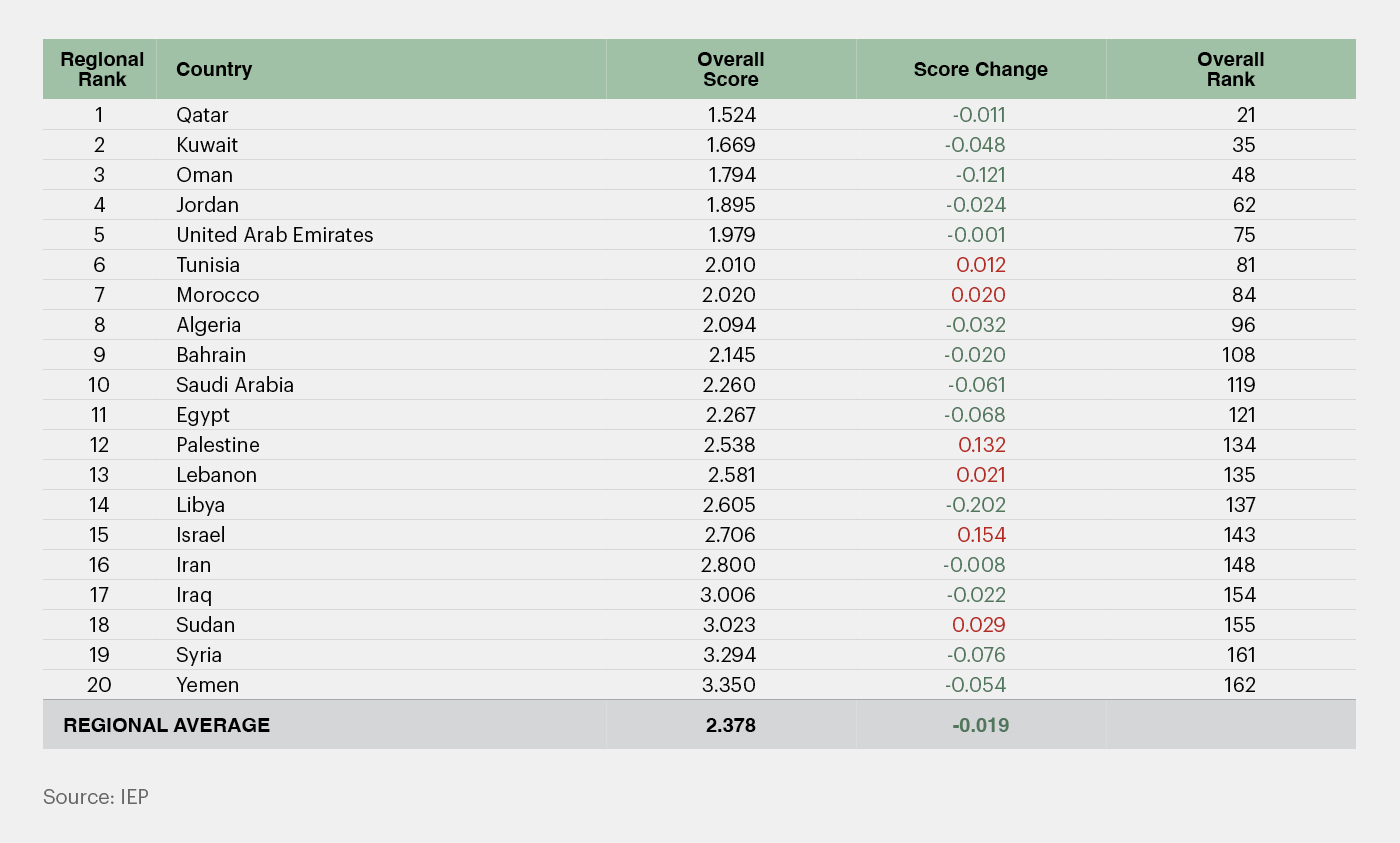
For the eighth consecutive year, the Middle East and North Africa (MENA) region remains the least peaceful in the world, despite showing consecutive improvements in peacefulness since 2020. MENA is home to four of the ten least peaceful countries globally. Over the past year, the region demonstrated a 0.63% overall improvement in peacefulness, with significant advancements in the Militarisation and Ongoing Conflict domains. Several post-conflict countries, including Libya, Syria, Iraq, and Yemen, experienced improvements in their peacefulness.
Libya stands out with the most substantial improvement in peacefulness in the region and globally, recording a 7.2% increase in its overall score. This marks the most peaceful state Libya has seen since the start of the second Libyan civil war in 2014. The improvement was driven by progress on the Ongoing Conflict domain, specifically in indicators related to deaths from internal conflict, internal conflicts fought and the intensity of internal conflict. A ceasefire agreement signed between the Government of National Accord and the Libyan National Army in August 2022 contributed to the improved chances of lasting peace.
Conversely, Israel experienced the largest deterioration in peacefulness within the MENA region, falling eight places to 143rd in the GPI rankings. The country’s overall peacefulness level reached its lowest point since 2010, primarily due to worsening relations with neighbouring Palestine and an increase in political instability. Intensifying conflicts between Israelis and Palestinians resulted in deteriorations in indicators related to terrorism impact and deaths from internal conflict. Moreover, political protests arose against government attempts to curtail the judiciary’s power, further contributing to the decline in political stability.
Qatar maintains its position as the most peaceful country in the MENA region, ranking among the top 25 most peaceful nations globally since 2008. In 2023, Qatar improved its overall peacefulness, driven by progress in political instability, external conflicts fought, and UN peacekeeping funding. The restoration of diplomatic relations with Saudi Arabia, the UAE, Bahrain, and Egypt in 2021 positively impacted the country’s internal political situation, leading to a full-year improvement in political stability.
Sudan ranks as the third least peaceful country in the MENA region, facing additional challenges with the eruption of conflict in mid-April 2023 between the Sudanese military and the Rapid Support Forces (RSF), a coalition of paramilitary groups. The violence is primarily driven by a power struggle over control of Sudan’s armed forces and roles in the ruling military regime. The fighting resulted in significant casualties and displacement, exacerbating the region’s overall instability.
Yemen remains the least peaceful country in the MENA region for the third consecutive year and the second least peaceful globally. However, there are promising signs of improvement, as Yemen recorded its first increase in peacefulness since 2017. Notably, violent demonstrations and neighbouring countries relations saw significant improvements. The ceasefire signed in April 2022 led to reduced Saudi airstrikes and Houthi cross-border attacks, although the ceasefire collapsed later in the year. Despite some localized conflicts and clashes, the overall level of violence reduced compared to previous years.

In the last eight years, the epicentre of terrorism has shifted out of South Asia and MENA and into sub-Saharan Africa and especially the Sahel. South Asia recorded a slight deterioration in peacefulness over the past year and remains the second least peaceful region overall. The average level of peacefulness in the region increased by 0.13 per cent, owing to deteriorations in the Militarisation and Safety and Security domains. Four of the seven countries in the region experienced improvements in peacefulness, while three deteriorated. There is a wide disparity between the least and most peaceful countries in the region, with Bhutan ranked 17th overall and Afghanistan being the least peaceful country in the world in the 2023 GPI.
Afghanistan has been the least peaceful country in the world for the past six years. However, it recorded a 2.73 per cent improvement in peacefulness in the past year, which was the fifth-largest improvement globally. Improvements in UN peacekeeping funding, the intensity of internal conflict and the armed services personnel rate drove the improvements of both the Militarisation and Ongoing Conflict domains. The terrorism impact indicator also improved for the fourth consecutive year, although terrorism remains a serious security concern.
The withdrawal of US troops and the Taliban’s recapture of Afghanistan in August 2021 led to a rapid fall in the number of deaths from internal conflict in late 2021 and throughout 2022. The intensity of internal conflict also improved due to fewer reported instances of hostilities between the Taliban and the National Resistance Front in 2022 and early 2023.
Bhutan is the most peaceful country in South Asia, despite recording the largest deterioration in the region over the past year. It is also the highest-ranking country on the GPI outside of Europe, Asia-Pacific and North America. Bhutan’s deterioration in the level of peacefulness over the past year was driven by a deterioration on the Political Terror Scale, as well as a 50 per cent deterioration on the violent demonstrations indicator. Despite the Militarisation domain deteriorating by just under three per cent, Bhutan remains one of the least militarised countries in the world, with the 15th lowest overall score on the Militarisation domain.
India is the most populous country in the region and ranks as the 126th most peaceful nation in the 2023 GPI. The country experienced an improvement of 3.5 per cent in overall peacefulness over the past year, owing to improvements in violent crime, neighbouring countries relations and political instability. The improvement in the neighbouring countries relations indicator occurred because of fewer incidences of cross-border violence and ceasefire violations with Pakistan and China in 2022. Furthermore, the reduction in geopolitical tensions with China owing to the reduction in border incidents, as well as less social unrest more generally, led to an improvement in the political instability indicator.

North America demonstrated the most substantial improvement in peacefulness among all regions in the 2023 Global Peace Index (GPI), with a positive change of 0.84%. Positioned as the third most peaceful region in the GPI, North America comprises two countries: Canada, which saw a 2.9% increase in peacefulness, and the United States, with a slight decline of 0.38% in its overall score. There exists a significant contrast in peacefulness between the two countries within the region.
Canada ranked as the 11th most peaceful country globally, while the United States stood at 131st place. Across the region, all three domains of peacefulness showed improvements. Nine out of 23 indicators improved, three deteriorated, and the remaining indicators remained unchanged. The indicators that experienced deterioration regionally were the homicide rate, perceptions of criminality, and weapons exports.
While North America fares better than the global average in Safety and Security and Ongoing Conflict domains, it scores poorly in the Militarisation domain, particularly in areas like military expenditure, nuclear and heavy weapons, and weapons exports. In Canada, overall peacefulness improved, driven by progress in the Ongoing Conflict and Safety and Security domains. Indicators related to the Political Terror Scale, terrorism impact, incarceration rate, and perceptions of criminality showed improvements. However, there was a slight decline in the Militarisation domain, attributed to an increase in weapons exports, although Canada remains among the top 25 countries with the highest levels of weapons exports per capita.
The United States experienced a minor decline in peacefulness over the past year, continuing a trend that started in 2015. Unlike previous years, civil unrest was not the primary driver of deterioration, as the violent demonstrations indicator improved by ten per cent, and political instability remained stable. The decline was mainly driven by deteriorations in the Safety and Security domain, particularly in indicators related to perceptions of criminality and the homicide rate. The United States recorded the fourth-largest overall increase in its homicide rate, surpassing six per 100,000 people, which is significantly higher than most Western European countries.
The centre of terrorism has shifted from the Middle East and North Africa to sub-Saharan Africa, particularly the Sahel region. Sub-Saharan Africa experienced a slight decrease in peacefulness in the 2023 GPI, with the overall score deteriorating by 0.57 per cent. Out of the 44 countries in the region, 21 showed improvements in their scores, while 22 experienced deterioration and one remained unchanged. Sub-Saharan Africa scores lower than the global average in the Safety and Security and Ongoing Conflict domains but fares better than the global average in the Militarisation domain. The decline in overall peacefulness in the region was mainly influenced by increases in internal conflicts, external conflicts, and violent demonstrations.
Mauritius is the most peaceful country in sub-Saharan Africa, ranked 23rd in the 2023 GPI. The country recorded a slight improvement of 1.8 per cent in its GPI score, attributed to advancements in the Militarisation and Safety and Security domains. The only indicators that deteriorated were political instability and military expenditure as a percentage of GDP, resulting from the re-emergence of Covid-19 infections in mid-2022, which led to economic uncertainty and public dissatisfaction with the government’s pandemic response.
On the other hand, South Sudan remains the least peaceful country in the region and one of the least peaceful globally. It experienced a one per cent deterioration in its overall score due to declines in the Ongoing Conflict and Militarisation domains. Internal conflicts continue to be prevalent, with internal conflicts fought and deaths from internal conflicts worsening over the past year. The armed services personnel rate and incarceration rate showed slight improvements, but the country still faces serious challenges related to violent crime, political instability, and the plight of refugees and internally displaced persons.
Burundi witnessed the most significant improvement in peacefulness, with a 5.3 per cent increase in its overall score, largely driven by improvements in the intensity of internal conflict and deaths from external conflict. Furthermore, the European Union’s decision to lift financial sanctions and resume direct financial assistance to the Burundian administration indicates progress in the country’s situation.
On the contrary, Mali experienced the largest deterioration in peacefulness in the region and the fourth-largest worldwide, with a 5.6 per cent decline in its overall score, mainly attributed to an escalation in the intensity of internal conflict. The conflict between the Malian government and Jihadist groups has intensified, resulting in clashes between various ethnic militias and an alarming increase in attacks against civilians. The number of conflict-related fatalities has risen significantly, highlighting the government’s failure to maintain control of its territory and allowing jihadist groups to carry out more attacks against government and UN forces.
Europe, known for being the most peaceful region globally and housing seven out of the top ten most peaceful countries in 2023, experienced a decline in peacefulness over the last year, with a slight increase of just over one per cent in its Global Peace Index (GPI) score. Among the 36 countries in the region, 12 saw improvements in peacefulness, while 23 faced deterioration. All three domains of Europe’s peacefulness showed declines, with the Ongoing Conflict domain experiencing the most significant deterioration. Indicators such as political instability, neighbouring countries relations and external conflicts fought contributed to these deteriorations, largely influenced by the ongoing war in Ukraine.
The impact of the Russia-Ukraine conflict extended globally, particularly in Europe. Among the five countries in Europe with the largest declines in peacefulness in 2023, three shared borders with Ukraine. These countries mainly experienced deteriorations in political instability and neighbouring countries relations indicators.
Iceland, consistently known as the most peaceful country in both Europe and the world since the inception of the GPI, recorded a four per cent decrease in its overall score. The rise in the homicide rate and terrorism impact indicator marked the first instance of terrorist activity in the country, with individuals arrested for plotting attacks against Icelandic parliament members and prominent politicians.
Conversely, Türkiye remained the least peaceful country in Europe and ranked below the top half of the index. It experienced a 1.7 per cent decrease in its overall score, driven by worsening conditions on the Ongoing Conflict and Safety and Security domains. Deaths from external conflict and the incarceration rate indicators rose significantly. Additionally, Türkiye’s active role as a major exporter of military technology, particularly drones, contributed to the deterioration in its weapons export indicator.
On a positive note, Montenegro showed the most improvement in peacefulness in the region and achieved the 45th position on the overall GPI index. This progress was driven by improvements in the Political Terror Scale, violent demonstrations, and UN peacekeeping funding indicators. However, the armed services personnel rate, military expenditure as a percentage of GDP, and weapons imports recorded slight deteriorations.
In contrast, Poland experienced the largest deterioration in peacefulness in Europe, falling six places to rank 29th in the overall index. All three domains showed declines, with the Ongoing Conflict domain experiencing the most significant drop at 14.4 per cent. The changing relationship with Russia resulting in a deterioration of neighbouring countries relations played a crucial role in Poland’s decline in peacefulness.
As a staunch advocate for a tough stance against Russia, Poland’s NATO membership and proximity to the Russian exclave of Kaliningrad further contributed to tensions. Additionally, Poland faced economic fallout from the war and Russia’s cut-off of gas supplies to the EU, impacting its overall peacefulness.
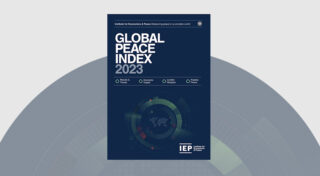
Download the Global Peace Index 2023.
Global Peace Index 2023